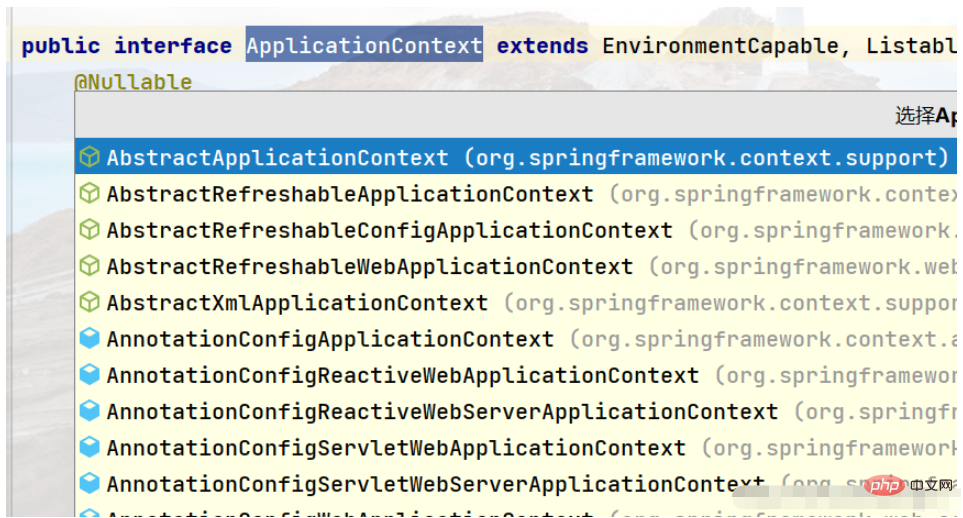ApplicationContextAware接口:
public interface ApplicationContextAware extends Aware {
void setApplicationContext(ApplicationContext applicationContext) throws BeansException;
}首先Aware接口就知道这是springboot扩展给用户使用的,这里提供了方法setApplicationContext,参数就是传递spring容器上下文对象进来,我们可以接收这个上下文对象,我们要想知道获取spring容器上下文ApplicationContext具体有什么作用,这才是扩展接口的目的所在,获取上下文根据上下文的特性做一些事情。
我们来看ApplicationContext对象的方法:

来看看AbstractApplicationContext实现类的方法:
public Object getBean(String name) throws BeansException {this.assertBeanFactoryActive();return this.getBeanFactory().getBean(name);}
public <T> T getBean(String name, Class<T> requiredType) throws BeansException {this.assertBeanFactoryActive();return this.getBeanFactory().getBean(name, requiredType);}
public Object getBean(String name, Object... args) throws BeansException {this.assertBeanFactoryActive();return this.getBeanFactory().getBean(name, args);}
public <T> T getBean(Class<T> requiredType) throws BeansException {this.assertBeanFactoryActive();return this.getBeanFactory().getBean(requiredType);}
public <T> T getBean(Class<T> requiredType, Object... args) throws BeansException {this.assertBeanFactoryActive();return this.getBeanFactory().getBean(requiredType, args);}
public <T> ObjectProvider<T> getBeanProvider(Class<T> requiredType) {this.assertBeanFactoryActive();return this.getBeanFactory().getBeanProvider(requiredType);}
public <T> ObjectProvider<T> getBeanProvider(ResolvableType requiredType) {this.assertBeanFactoryActive();return this.getBeanFactory().getBeanProvider(requiredType);}
public boolean containsBean(String name) {return this.getBeanFactory().containsBean(name);}
public boolean isSingleton(String name) throws NoSuchBeanDefinitionException {this.assertBeanFactoryActive();return this.getBeanFactory().isSingleton(name);}
public boolean isPrototype(String name) throws NoSuchBeanDefinitionException {this.assertBeanFactoryActive();return this.getBeanFactory().isPrototype(name);}这里我们可以发现 getBean()方法很眼熟,因为在最最开始学习spring时没有用spring的脚手架创建项目,我们获取bean的方法通常是classPathContextLoader扫描bean的xml文件解析组成ApplicationCOntext对象,再调用它的getBean方法获取实例bean。
由此可以发现我们主要的应用途径就是使用这个getBean的方法,那么动态的注入bean我们通过很多方法就能实现,所以这里不难想到,静态方法中无法使用注入的bean的问题。
其次我们来复现这个问题,大家来看如下的代码:
public class JsonGetter {
@Resource
private UuidGetter uuidGetter;
public static string Test(){
return uuidGetter.getUuid();
}
public static JsONobject set0bjectToJsonObject(object data){
return JsoNobject.parseObject(String.valueof(JsONObject.toJSON(data)));
}
public static JsONObject setStringTO3son0bject(String data) { return JsONObject.parseObject(data);
}我们发现在静态的Test方法中调用注入的bean直接报错,这里解释一下:归功于类的加载机制与加载顺序,静态属性与静态代码块最先加载(static静态优先),这里加载静态方法是没有bean实例给你用的,自然会报错。
如何解决?我们可以采取Spring获取bean对象时调用getBean方法的思路,在容器加载时将spring容器的上下文进行静态存储:
@Component
@Lazy(value = false)
public class SpringContextHolder implements ApplicationContextAware, DisposableBean {
/**
* 将上下文静态设置,在初始化组件时就进行静态上下文的覆盖(这个覆盖是将远spring容器的上下文对象引用加到我们预定设置)
*/
private static ApplicationContext applicationContext = null;
public static ApplicationContext getApplicationContext() {
assertContextInjected();
return applicationContext;
}
@SuppressWarnings("unchecked")
public static <T> T getBean(String name) {
assertContextInjected();
return (T) applicationContext.getBean(name);
}
public static <T> T getBean(Class<T> beanType) {
assertContextInjected();
return applicationContext.getBean(beanType);
}
@Override
public void setApplicationContext(@NotNull ApplicationContext applicationContext) throws BeansException {
SpringContextHolder.applicationContext = applicationContext;
}
@Override
public void destroy() {
applicationContext = null;
}
private static void assertContextInjected() {
Assert.notNull(applicationContext,
"applicationContext属性未注入, 请在applicationContext.xml中定义SpringContextHolder.");
}
public static void pushEvent(ApplicationEvent event){
assertContextInjected();
applicationContext.publishEvent(event);
}
}这里只需要关注的是静态成员变量ApplicationContext的定义、赋值与验证:
/**
* 将上下文静态设置,在初始化组件时就进行静态上下文的覆盖(这个覆盖是将远spring容器的上下文对象引用加到我们预定设置)
*/
private static ApplicationContext applicationContext = null;重写扩展接口的方法,实现静态上下文的覆盖:
@Override
public void setApplicationContext(@NotNull ApplicationContext applicationContext) throws BeansException {
SpringContextHolder.applicationContext = applicationContext;
}将获取它的方法公有修饰,便于共享:
public static ApplicationContext getApplicationContext() {
assertContextInjected();
return applicationContext;
}写到这里还是不明白,这么定义一个组件,将spring上下文对象静态覆盖到底有何作用?
不要慌,我们来看看这个类的这个方法:
public class AppContext {
static transient ThreadLocal<Map<String, String>> contextMap = new ThreadLocal<>();
......省略n行业务代码
public static void fillLoginContext() {
DingAppInfo appInfo = SpringContextHolder.getBean(DingAppInfoService.class).findAppInfo(APP_CODE);
setDingVerifyInfo(appInfo);
CloudChatAppInfo cloudChatAppInfo = SpringContextHolder.getBean(CloudChatAppInfoService.class).findAppInfo(APP_CODE);
setCloudChatInfo(cloudChatAppInfo);
}
public static void clear() {
contextMap.remove(); //本地线程的remove方法极其重要,注意每次给它使用之后一定要调用remove清理,防止内存泄露。
}
}我们发现上例代码中进行了查库的操作:
DingAppInfo appInfo = SpringContextHolder.getBean(DingAppInfoService.class).findAppInfo(APP_CODE);
以上是SpringBoot ApplicationContextAware拓展接口如何使用的详细内容。更多信息请关注PHP中文网其他相关文章!
 JVM如何促进Java的'写作一次,在任何地方运行”(WORA)功能?May 02, 2025 am 12:25 AM
JVM如何促进Java的'写作一次,在任何地方运行”(WORA)功能?May 02, 2025 am 12:25 AMJVM通过字节码解释、平台无关的API和动态类加载实现Java的WORA特性:1.字节码被解释为机器码,确保跨平台运行;2.标准API抽象操作系统差异;3.类在运行时动态加载,保证一致性。
 Java的较新版本如何解决平台特定问题?May 02, 2025 am 12:18 AM
Java的较新版本如何解决平台特定问题?May 02, 2025 am 12:18 AMJava的最新版本通过JVM优化、标准库改进和第三方库支持有效解决平台特定问题。1)JVM优化,如Java11的ZGC提升了垃圾回收性能。2)标准库改进,如Java9的模块系统减少平台相关问题。3)第三方库提供平台优化版本,如OpenCV。
 说明JVM执行的字节码验证的过程。May 02, 2025 am 12:18 AM
说明JVM执行的字节码验证的过程。May 02, 2025 am 12:18 AMJVM的字节码验证过程包括四个关键步骤:1)检查类文件格式是否符合规范,2)验证字节码指令的有效性和正确性,3)进行数据流分析确保类型安全,4)平衡验证的彻底性与性能。通过这些步骤,JVM确保只有安全、正确的字节码被执行,从而保护程序的完整性和安全性。
 平台独立性如何简化Java应用程序的部署?May 02, 2025 am 12:15 AM
平台独立性如何简化Java应用程序的部署?May 02, 2025 am 12:15 AMJava'splatFormIndepentEncealLowsApplicationStorunonAnyOperatingsystemwithajvm.1)singleCodeBase:writeandeandcompileonceforallplatforms.2)easileupdates:updatebybytecodeforsimultaneDeployment.3)testOnOneOnePlatForforuluniverSalpeforuluniverSaliver.4444.4444
 Java的平台独立性如何随着时间的流逝而发展?May 02, 2025 am 12:12 AM
Java的平台独立性如何随着时间的流逝而发展?May 02, 2025 am 12:12 AMJava的平台独立性通过JVM、JIT编译、标准化、泛型、lambda表达式和ProjectPanama等技术不断增强。自1990年代以来,Java从基本的JVM演进到高性能的现代JVM,确保了代码在不同平台的一致性和高效性。
 在Java应用程序中缓解平台特定问题的策略是什么?May 01, 2025 am 12:20 AM
在Java应用程序中缓解平台特定问题的策略是什么?May 01, 2025 am 12:20 AMJava如何缓解平台特定的问题?Java通过JVM和标准库来实现平台无关性。1)使用字节码和JVM抽象操作系统差异;2)标准库提供跨平台API,如Paths类处理文件路径,Charset类处理字符编码;3)实际项目中使用配置文件和多平台测试来优化和调试。
 Java的平台独立性与微服务体系结构之间有什么关系?May 01, 2025 am 12:16 AM
Java的平台独立性与微服务体系结构之间有什么关系?May 01, 2025 am 12:16 AMjava'splatformentenceenhancesenhancesmicroservicesharchitecture byferingDeploymentFlexible,一致性,可伸缩性和便携性。1)DeploymentFlexibilityAllowsibilityAllowsOllowsOllowSorlowsOllowsOllowsOllowSeStorunonAnyPlatformwithajvM.2)penterencyCrossServAccAcrossServAcrossServiCessImplifififiesDeevelopmentandeDe
 GRAALVM与Java的平台独立目标有何关系?May 01, 2025 am 12:14 AM
GRAALVM与Java的平台独立目标有何关系?May 01, 2025 am 12:14 AMGraalVM通过三种方式增强了Java的平台独立性:1.跨语言互操作,允许Java与其他语言无缝互操作;2.独立的运行时环境,通过GraalVMNativeImage将Java程序编译成本地可执行文件;3.性能优化,Graal编译器生成高效的机器码,提升Java程序的性能和一致性。


热AI工具

Undresser.AI Undress
人工智能驱动的应用程序,用于创建逼真的裸体照片

AI Clothes Remover
用于从照片中去除衣服的在线人工智能工具。

Undress AI Tool
免费脱衣服图片

Clothoff.io
AI脱衣机

Video Face Swap
使用我们完全免费的人工智能换脸工具轻松在任何视频中换脸!

热门文章

热工具

SublimeText3汉化版
中文版,非常好用

VSCode Windows 64位 下载
微软推出的免费、功能强大的一款IDE编辑器

Dreamweaver CS6
视觉化网页开发工具

Dreamweaver Mac版
视觉化网页开发工具

SublimeText3 Linux新版
SublimeText3 Linux最新版





